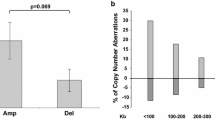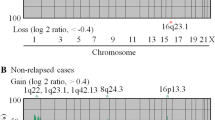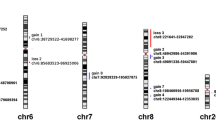Abstract
We reinvestigated rearrangements occurring in region q13 of chromosome 11 aiming to: (i) describe heterogeneity of the observed structural alterations, (ii) estimate amplicon size and (iii) identify of oncogenes involved in laryngeal cancer progression as potential targets for therapy. The study included 17 cell lines derived from laryngeal cancers and 34 specimens from primary laryngeal tumors. The region 11q13 was analyzed by fluorescence in situ hybridization (FISH), array comparative genomic hybridization (aCGH) and gene expression microarray. Next, quantitative real time PCR was used for chosen genes to confirm results from aCGH and gene expression microarray. The observed pattern of aberrations allows to distinguish three ways, in which gain and amplification involving 11q13 region may occur: formation of a homogeneously staining region; breakpoints in/near 11q13, which lead to the three to sevenfold increase of the copy number of 11q13 region; the presence of additional copies of the whole chromosome 11. The minimal altered region of gain and/or amplification was limited to ~1.8 Mb (chr.11:69,395,184–71,209,568) and comprised mostly 11q13.3 band which contain 12 genes. Five, out of these genes (CCND1, ORAOV1, FADD, PPFIA1, CTTN) had higher expression levels in comparison to healthy controls. Apart from CCND1 gene, which has an established role in pathogenesis of head and neck cancers, CTTN, ORAOV1 and FADD genes appear to be oncogene-candidates in laryngeal cancers, while a function of PPFIA1 requires further studies.



Similar content being viewed by others
Abbreviations
- BAC:
-
Bacterial artificial chromosome
- CGH array:
-
Comparative genome hybridization
- HNSCC:
-
Head neck squamous cell carcinoma
- HPV:
-
Human papilloma virus
- LSCC:
-
Laryngeal squamous cell carcinoma
- MAR:
-
Minimal altered region
References
Ha PK, Califano JA (2003) The molecular biology of mucosal field cancerization of the head and neck. Crit Rev Oral Biol Med 14(5):363–369
Rautava J, Kuuskoski J, Syrjanen K, Grenman R, Syrjanen S (2012) HPV genotypes and their prognostic significance in head and neck squamous cell carcinomas. J Clin Virol 53(2):116–120. doi:10.1016/j.jcv.2011.11.005
Wang LX, Agulnik M (2008) Promising newer molecular-targeted therapies in head and neck cancer. Drugs 68(12):1609–1619
Meredith SD, Levine PA, Burns JA, Gaffey MJ, Boyd JC, Weiss LM, Erickson NL, Williams ME (1995) Chromosome 11q13 amplification in head and neck squamous cell carcinoma. Association with poor prognosis. Arch Otolaryngol Head Neck Surg 121(7):790–794
Mielcarek-Kuchta D, Olofsson J, Golusinski W (2003) p53, Ki67 and cyclin D1 as prognosticators of lymph node metastases in laryngeal carcinoma. Eur Arch Otorhinolaryngol 260(10):549–554. doi:10.1007/s00405-003-0651-6
Xiao-Ping H, Tie-Hua R, Peng L, Qiu-Liang W, Guang-Yu Y, Jing-Hui H, Xiao-Dong S, Xiao-Dong L, Bao-Jiang L, Peng-Yuan Z, Kai L, Zhi-Fan H (2006) Cyclin D1 overexpression in esophageal cancer from southern China and its clinical significance. Cancer Lett 231(1):94–101. doi:10.1016/j.canlet.2005.01.040
Fortin A, Guerry M, Guerry R, Talbot M, Parise O, Schwaab G, Bosq J, Bourhis J, Salvatori P, Janot F, Busson P (1997) Chromosome 11q13 gene amplifications in oral and oropharyngeal carcinomas: no correlation with subclinical lymph node invasion and disease recurrence. Clin Cancer Res 3(9):1609–1614
Huang C, Yang L, Li Z, Yang J, Zhao J, Dehui X, Liu L, Wang Q, Song T (2007) Detection of CCND1 amplification using laser capture microdissection coupled with real-time polymerase chain reaction in human esophageal squamous cell carcinoma. Cancer Genet Cytogenet 175(1):19–25. doi:10.1016/j.cancergencyto.2007.01.003
Leemans CR, Braakhuis BJ, Brakenhoff RH (2011) The molecular biology of head and neck cancer. Nat Rev Cancer 11(1):9–22. doi:10.1038/nrc2982
Papadimitrakopoulou VA, Izzo J, Mao L, Keck J, Hamilton D, Shin DM, El-Naggar A, den Hollander P, Liu D, Hittelman WN, Hong WK (2001) Cyclin D1 and p16 alterations in advanced premalignant lesions of the upper aerodigestive tract: role in response to chemoprevention and cancer development. Clin Cancer Res 7(10):3127–3134
Izzo JG, Papadimitrakopoulou VA, Liu DD, den Hollander PL, Babenko IM, Keck J, El-Naggar AK, Shin DM, Lee JJ, Hong WK, Hittelman WN (2003) Cyclin D1 genotype, response to biochemoprevention, and progression rate to upper aerodigestive tract cancer. J Natl Cancer Inst 95(3):198–205
Huang M, Spitz MR, Gu J, Lee JJ, Lin J, Lippman SM, Wu X (2006) Cyclin D1 gene polymorphism as a risk factor for oral premalignant lesions. Carcinogenesis 27(10):2034–2037. doi:10.1093/carcin/bgl048
Rydzanicz M, Golusinski P, Mielcarek-Kuchta D, Golusinski W, Szyfter K (2006) Cyclin D1 gene (CCND1) polymorphism and the risk of squamous cell carcinoma of the larynx. Eur Arch Otorhinolaryngol 263(1):43–48. doi:10.1007/s00405-005-0957-7
Rodrigo JP, Garcia LA, Ramos S, Lazo PS, Suarez C (2000) EMS1 gene amplification correlates with poor prognosis in squamous cell carcinomas of the head and neck. Clin Cancer Res 6(8):3177–3182
Gibcus JH, Menkema L, Mastik MF, Hermsen MA, de Bock GH, van Velthuysen ML, Takes RP, Kok K, Alvarez Marcos CA, van der Laan BF, van den Brekel MW, Langendijk JA, Kluin PM, van der Wal JE, Schuuring E (2007) Amplicon mapping and expression profiling identify the Fas-associated death domain gene as a new driver in the 11q13.3 amplicon in laryngeal/pharyngeal cancer. Clin Cancer Res 13(21):6257–6266. doi:10.1158/1078-0432.CCR-07-1247
Jarvinen AK, Autio R, Haapa-Paananen S, Wolf M, Saarela M, Grenman R, Leivo I, Kallioniemi O, Makitie AA, Monni O (2006) Identification of target genes in laryngeal squamous cell carcinoma by high-resolution copy number and gene expression microarray analyses. Oncogene 25(52):6997–7008. doi:10.1038/sj.onc.1209690
Tan KD, Zhu Y, Tan HK, Rajasegaran V, Aggarwal A, Wu J, Wu HY, Hwang J, Lim DT, Soo KC, Tan P (2008) Amplification and overexpression of PPFIA1, a putative 11q13 invasion suppressor gene, in head and neck squamous cell carcinoma. Genes Chromosomes Cancer 47(4):353–362. doi:10.1002/gcc.20539
Jarmuz M, Grenman R, Golusinski W, Szyfter K (2005) Aberrations of 11q13 in laryngeal squamous cell lines and their prognostic significance. Cancer Genet Cytogenet 160(1):82–88. doi:10.1016/j.cancergencyto.2004.12.006
Chomczynski P (1993) A reagent for the single-step simultaneous isolation of RNA, DNA and proteins from cell and tissue samples. Biotechniques 15 (3):532–534, 536–537
Giefing M, Martin-Subero JI, Kiwerska K, Jarmuz M, Grenman R, Siebert R, Szyfter K (2008) Characterization of homozygous deletions in laryngeal squamous cell carcinoma cell lines. Cancer Genet Cytogenet 184(1):38–43. doi:10.1016/j.cancergencyto.2008.03.004
Giefing M, Zemke N, Brauze D, Kostrzewska-Poczekaj M, Luczak M, Szaumkessel M, Pelinska K, Kiwerska K, Tonnies H, Grenman R, Figlerowicz M, Siebert R, Szyfter K, Jarmuz M (2011) High resolution ArrayCGH and expression profiling identifies PTPRD and PCDH17/PCH68 as tumor suppressor gene candidates in laryngeal squamous cell carcinoma. Genes Chromosomes Cancer 50(3):154–166. doi:10.1002/gcc.20840
Kostrzewska-Poczekaj M, Giefing M, Jarmuz M, Brauze D, Pelinska K, Grenman R, Bartochowska A, Szyfter W, Szyfter K (2010) Recurrent amplification in the 22q11 region in laryngeal squamous cell carcinoma results in overexpression of the CRKL but not the MAPK1 oncogene. Cancer Biomark 8(1):11–19. doi:10.3233/DMA-2011-0814
Wessa P (2012) Pearson Correlation (v1.0.6) in Free Statistics Software (v1.1.23-r7), Office for Research Development and Education. http://www.wessa.net/rwasp_correlation.wasp/
Shaffer LG, McCaskill C, Han JY, Choo KH, Cutillo DM, Donnenfeld AE, Weiss L, Van Dyke DL (1994) Molecular characterization of de novo secondary trisomy 13. Am J Hum Genet 55(5):968–974
Freier K, Sticht C, Hofele C, Flechtenmacher C, Stange D, Puccio L, Toedt G, Radlwimmer B, Lichter P, Joos S (2006) Recurrent coamplification of cytoskeleton-associated genes EMS1 and SHANK2 with CCND1 in oral squamous cell carcinoma. Genes Chromosomes Cancer 45(2):118–125. doi:10.1002/gcc.20270
Tremmel SC, Gotte K, Popp S, Weber S, Hormann K, Bartram CR, Jauch A (2003) Intratumoral genomic heterogeneity in advanced head and neck cancer detected by comparative genomic hybridization. Cancer Genet Cytogenet 144(2):165–174
Jin C, Jin Y, Gisselsson D, Wennerberg J, Wah TS, Stromback B, Kwong YL, Mertens F (2006) Molecular cytogenetic characterization of the 11q13 amplicon in head and neck squamous cell carcinoma. Cytogenet Genome Res 115(2):99–106. doi:10.1159/000095228
Shuster MI, Han L, Le Beau MM, Davis E, Sawicki M, Lese CM, Park NH, Colicelli J, Gollin SM (2000) A consistent pattern of RIN1 rearrangements in oral squamous cell carcinoma cell lines supports a breakage–fusion–bridge cycle model for 11q13 amplification. Genes Chromosomes Cancer 28(2):153–163
Gibcus JH, Kok K, Menkema L, Hermsen MA, Mastik M, Kluin PM, van der Wal JE, Schuuring E (2007) High-resolution mapping identifies a commonly amplified 11q13.3 region containing multiple genes flanked by segmental duplications. Hum Genet 121(2):187–201. doi:10.1007/s00439-006-0299-6
Lin M, Smith LT, Smiraglia DJ, Kazhiyur-Mannar R, Lang JC, Schuller DE, Kornacker K, Wenger R, Plass C (2006) DNA copy number gains in head and neck squamous cell carcinoma. Oncogene 25(9):1424–1433. doi:10.1038/sj.onc.1209166
Akervall J, Borg A, Dictor M, Jin C, Jin Y, Tanner M, Isola J, Mertens F, Wennerberg J (2002) Chromosomal translocations involving 11q13 contribute to cyclin D1 overexpression in squamous cell carcinoma of the head and neck. Int J Oncol 20(1):45–52
Bellacosa A, Almadori G, Cavallo S, Cadoni G, Galli J, Ferrandina G, Scambia G, Neri G (1996) Cyclin D1 gene amplification in human laryngeal squamous cell carcinomas: prognostic significance and clinical implications. Clin Cancer Res 2(1):175–180
Serra-Pages C, Kedersha NL, Fazikas L, Medley Q, Debant A, Streuli M (1995) The LAR transmembrane protein tyrosine phosphatase and a coiled-coil LAR-interacting protein co-localize at focal adhesions. EMBO J 14(12):2827–2838
Asperti C, Astro V, Totaro A, Paris S, de Curtis I (2009) Liprin-alpha1 promotes cell spreading on the extracellular matrix by affecting the distribution of activated integrins. J Cell Sci 122(Pt 18):3225–3232. doi:10.1242/jcs.054155
Shen JC, Unoki M, Ythier D, Duperray A, Varticovski L, Kumamoto K, Pedeux R, Harris CC (2007) Inhibitor of growth 4 suppresses cell spreading and cell migration by interacting with a novel binding partner, liprin alpha1. Cancer Res 67(6):2552–2558. doi:10.1158/0008-5472.CAN-06-3870
Dancau AM, Wuth L, Waschow M, Holst F, Krohn A, Choschzick M, Terracciano L, Politis S, Kurtz S, Lebeau A, Friedrichs K, Wencke K, Monni O, Simon R (2010) PPFIA1 and CCND1 are frequently coamplified in breast cancer. Genes Chromosomes Cancer 49(1):1–8. doi:10.1002/gcc.20713
Huang X, Gollin SM, Raja S, Godfrey TE (2002) High-resolution mapping of the 11q13 amplicon and identification of a gene, TAOS1, that is amplified and overexpressed in oral cancer cells. Proc Natl Acad Sci USA 99(17):11369–11374. doi:10.1073/pnas.172285799
Acknowledgments
This work was funded by the Polish Ministry of Science and Higher Education Grants, numbers N 403 03 232/1989 and N 401 192 32/4031. We thank Prof. Reiner Siebert (Institute of Human Genetics, University Hospital Schleswig-Holstein Campus Kiel, Christian—Albrechts University 24105 Kiel, Germany) for possibility to perform microarray CGH experiments.
Conflict of interest
The authors declare that they have no conflict of interest.
Ethical standard
We declare that all experiments were performed in accordance with the current law of Poland.
Author information
Authors and Affiliations
Corresponding author
Electronic supplementary material
Below is the link to the electronic supplementary material.
Rights and permissions
About this article
Cite this article
Jarmuz-Szymczak, M., Pelinska, K., Kostrzewska-Poczekaj, M. et al. Heterogeneity of 11q13 region rearrangements in laryngeal squamous cell carcinoma analyzed by microarray platforms and fluorescence in situ hybridization. Mol Biol Rep 40, 4161–4171 (2013). https://doi.org/10.1007/s11033-013-2496-4
Received:
Accepted:
Published:
Issue Date:
DOI: https://doi.org/10.1007/s11033-013-2496-4




